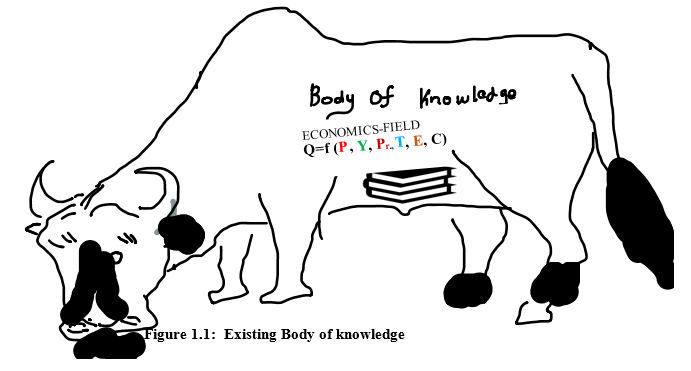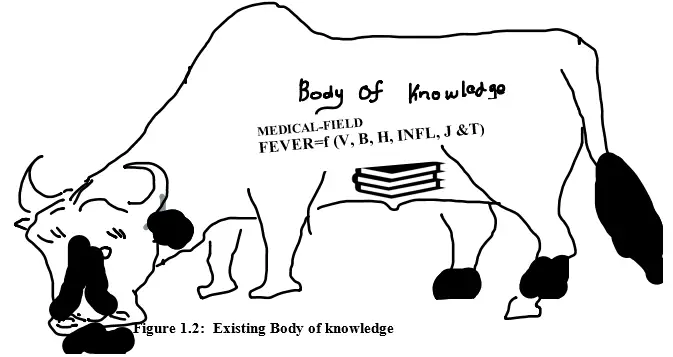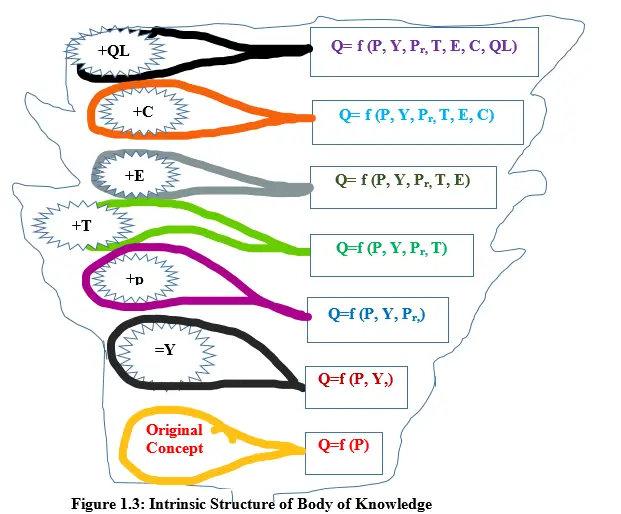Body of knowledge
What is body of knowledge?
1.1 Definition
Body of knowledge (BOK) is the summation or collection of all known theories in a certain discipline. Collection of theories refers to complete set of concepts, terms and activities that make up a professional domain be it Social Sciences, medical or political just to mention but a few.
Or
It is a domain characterized by all plausible or logical relationships that exist between or amongst two constructs (variables) in the natural phenomenon.
For example, let us consider some fields and the corresponding body of knowledge.
Example 1: -Economics
On the perspective of demand, we can consider all the factors that determine demand level of a normal good. This is what is already known;
Price of the Product (Pe)
The Consumer's Income (Y)
The Price of Related Goods (Pr)
Tastes and Preferences of Consumers (T)
The Consumer's Expectations (E)
The Number of Consumers in the Market (C)
Assuming that I have included all the factors that affect demand of a commodity, we can say precisely that this represents the existing body of knowledge as pertains the factors that directly predict or estimate the level of demand of a normal good. Look at this model below

In other words, the body of existing knowledge is also empirically represented by all those factors which are pure predictors of the level of demand of normal goods. I have diagrammatically presented that concept by using Figure 1.1 below

NB1: I have used a live cow diagram to imply that as a researcher or scholar, you should understand that body of knowledge in Economics is not static. It is like a cow that has a body with components of relationships which keep on increasing with time. The cow is still feeding on grass and that means although yesterday it fed, today its feeding and tomorrow it will move on feeding the more. So, in the same manner, body of knowledge is dynamic as long as more researchers are showing interest in this field and interrogating other factors which naturally link with already existing ones. The new knowledge discovered is additive in nature.
Example 2: Medical field
In the health sector, it is already proven empirically that Fever is caused by
Virus (V)
Bacterial infection(B).
Heat exhaustion(H).
Certain inflammatory conditions such as Rheumatoid arthritis — inflammation of the lining of your joints (INFL)
Malignant Tumor (T).
That is
FEVER=f (V, B, H, INFL, J &T)
In other words, in the body of existing knowledge, it is empirically proven that all those factors are pure predictors of Fever in the body of human beings as indicated by Figure 1.2

NB2: I have used a live cow diagram to imply that as a researcher or scholar, you should understand that body of knowledge in Health Science is not static. It is like a cow that has a body with components of relationships which keep on increasing with time. The cow is still feeding on grass and that means although yesterday it fed, today its feeding and tomorrow it will move on feeding the more. So, in the same manner, body of knowledge is dynamic as long as more researchers are showing interest in this field and interrogating other factors which naturally link with already existing ones. The new knowledge discovered is additive in nature.
In conclusion
All fields have similar argument as it is in these two cases as per Figure 1.1 and 1.2 above.
How do we progressively develop new knowledge?
This question above reminds me of a term commonly used amongst researchers and postgraduate scholars; the term “My THESIS” But it is always very hard for the same fellows to further substantiate what a thesis means and its role in research. Most scholars when asked what their THESIS was, they struggle to remember the topic of their masters or PhD project. This way, they get it wrong. THESIS does not imply the TOPIC or TITLE of some Masters or PhD work. As I demonstrate to you the diverse ways of contribution to body of knowledge, allow me to remind you on a certain concept we learned in the formulation of effective hypothesis article.
As per our discussion in the formulation of effective hypothesis article, one’s new contribution to the already existing body of knowledge entail introduction of a new study variable(s) that carry either a conceptual/theoretical, methodological or contextual explanation on the already existing body of knowledge.
In other words, the researcher has to demonstrate how he fills the conceptual or methodological or contextual knowledge gap in an already existing relationship between two or more variables. The following illustration will clarify this aspect.
Illustration 1
If Y is significantly determined by X, then X is a predictor variable of Y (the dependent variable).
This is body of existing knowledge. If the researcher further proves that Z also significantly influence Y then this is new contribution to the already existing body of knowledge (i.e., Y=f(X)). This is the case f it is empirically proven so.
Y is now proven to be a function of both X and Z and not as it was before.
Let us further look at the scenarios of some of the different domains we have in the world such as Economics
We realized that in the already existing body of knowledge, all the factors that determine demand level of a normal good are as;
Price of the Product (P)
The Consumer's Income (Y)
The Price of Related Goods (Pr)
Tastes and Preferences of Consumers (T)
The Consumer's Expectations (E)
The Number of Consumers in the Market (C)
Assuming that I have included all the factors that affect demand of a commodity, this represents the existing body of knowledge as pertains the factors that directly predict or estimate the level of demand of a normal good. This can empirically be presented as;
Q=f (P, Y, PR, T, E, C) which can be read as; Quantity demanded is a function(f) P, Y, PR, T, E, and C
NB3: A function (f) means demand for the goods is determined or predicted by the aforementioned factors.
Now if one carries out further research on factors that determine the quantity demanded of a normal good or commodity, and then a factor such as Quality (QL) of the good is empirically proven that it determines the quantity demanded by the customers, then this becomes new knowledge if the factor quality (QL) significantly estimate or predict the quantity demanded of that commodity.
Therefore; the existing body of knowledge expressed empirically as Q=f (P, Y, PR, T, E, C) will now turn to be Q=f (P, Y, Pr, T, E, C, QL). Where by QL is quality of the good. Our article on formulation of effective hypothesis provides the point of detail on other ways in which new contribution can be made to the already existing body of knowledge.
In a nutshell; body of knowledge can diagrammatically be presented as live tree (hint: use demand function) as revealed in Figure 1.3

NB: You see, like a live tree, it keeps on accessing more water and minerals which are compatible to the already existing components of the tree and we outwardly witness new branches and leaves and in the long-run we observe fruits as end results. Similarly, in research, there is the very original concept, as indicated in Figure 1.3 above whereby more and more concepts and/or interrelationship of more variables/constructs are brought to board and the body of knowledge broaden. This will be the case as long as interested researchers/scholars in that particular domain are adding new knowledge.
How to contribute to body of existing knowledge?
There are many ways of contributing to existing body of knowledge. Some of the ways are
- Literature review
- Experience
- Discovery of new ideas
Characteristics of body of knowledge in research
Body of knowledge is the resting point for any new knowledge in research. After the lengthy process of research, the research findings land in the already existing body of knowledge. The following are some of the characteristics of this view point.
- Body of knowledge is progressive-that is, its content keeps on growing as long as new needs arise and more research activities in that domain are being undertaken.
- Composed of theoretical components-body of knowledge is characterized on only the plausible relationships or concepts. If two or more variables are not logical, they cannot form new knowledge.
- Form body of past literature. It is the data bank of past studies that is used to develop literature review.
- Foundation for Knowledge gaps in a study-body of knowledge is the basis through which researchers develop research gaps of conceptual, methodological and conceptual nature.
- Historical-body of knowledge is a bank of past period information collected by researchers.
- Significant research findings-body of knowledge is made up of statistically significant links between two or amongst more than two variables.
Importance of body of knowledge
- Source of information for further research activities.
- Development of theories in different fields.
- Provide data and information for industrial solutions and in other fields.
- Source of innovation-past knowledge in the body of knowledge help in creativity.
- Body of knowledge envisage comprehensive set of concepts, terms, tools, and activities that make up a profession.
Conclusion
From this study, it is crystal clear that;
- Body of knowledge is a collection of concepts, starting with the smallest (and this does not mean the smallest is the most subordinate as compared to others) to the most current.
- Body of knowledge is progressively built up.
- The additional knowledge is made up of an additional variable/construct identified and should have a statistically significant contribution
- From (iii) above, if a new variable(s) is introduced in the already existing body of knowledge and it is NOT statistically significant, such is not a THESIS and does not form new scientific knowledge and therefore should be thrown through the window. i.e., decayed.
- The professionals and other body of knowledge players require that anybody claiming or postulating to contribute new knowledge it does not then matter how small it is so long as it is statistically significant.
- Any new knowledge as a result of chance alone is not acceptable in the world of research. This is where the Null Hypothesis is TRUE. For this implies that the change witnessed in the dependent variable is due to chance only.